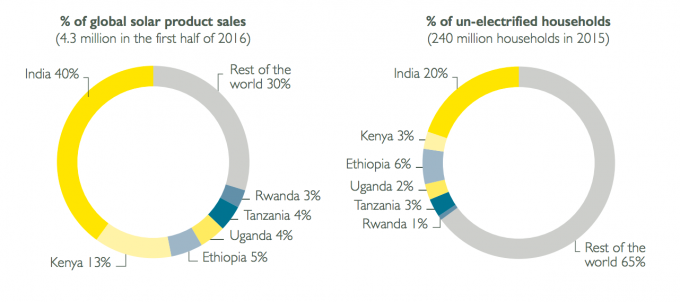Access to energy: how far has the market come?
Solar lanterns, solar home systems, clean energy microgrids, improved cookstoves… just to name a few of what is a long list of technologies providing access to energy to low-income populations in developing countries. However, despite the availability of all these technologies, and the dedication of more and more companies to provide and improve them, there remains one question: why do more than one billion people still not have access to electricity and use harmful cooking facilities?
In this month’s theme, which Editor Caroline Ashley and Markus Dietrich introduce here, we have partnered with Hystra, who have recently released new research on opportunities to scale energy access solutions. We explore the lessons learnt by practitioners, such as Solar Now and Simpa, trends in business models and market penetration, and we hear from Acumen on understanding and measuring impact. Keep an eye out for our upcoming webinar in September, when you will be able to ask questions of the researchers and practitioners directly. Details to be released soon.
How far has the market come?
- Start here for high level findings about market trends based on in-depth research from the team at Hystra. Four key issues arise: scale given the size of unmet needs, depth down the pyramid to rural and poor households, insufficient intensity for productive use, and questions on sustainability of the business models.
Solar: putting clients’ needs first
- Do customers “graduate” linearly from small solar energy products to higher levels of energy service? The first blog in a series from UNCDF’s CleanStart Programme in partnership with SolarAid/Acumen, shows that in Uganda there is a high willingness to pay for reliable electricity services - an unmet demand that could be met by solar enterprises. Read more.
- Solar companies find it hard to transition from being product sellers to problem solvers. Here are some great tips from SolarNow on how they put technical fixes back in their box, to put people (clients and agents) first in Uganda. Read more.
- In Nigeria, the founder of Lumos explains their perspective on scaling the solar market through piggybacking on mobile airtime. Lumos partners with MTN in Nigeria, who sell the solar products and customers pay just as they do for their airtime. Read more.
New research from Hystra: ‘Reaching scale in access to energy’
Drawing lessons from the in-depth analysis of 26 pioneer practitioners, this new report looks at a range of off-grid energy solutions and explores the opportunities to scale energy access. Read more.
- The energy sector in India lacks sophistication in its engagement with market segments, compared to the FMCG sector. Mitali Sahni from Simpa argues that a focus on understanding target population is needed to design and market more suitable products and services. Read more.
- Five East African countries and densely-populated regions of India still account for 70% of global sales of solar products, yet they only account for 35% of the global off-grid population. Hystra explores what will be needed for the industry to move beyond the near-saturation markets and lays down a challenge to enterprises, investors and donors, on how to tackle lack of customer care and quality assurance. Read more.

Unreached segments: creating a truly inclusive electrification strategy
- What to do about the unreached segments? Ideas on how to combine donor input with market based approaches, including results based finance, are discussed by the Hystra team. Read more.
- The expanding solar industry is simply not reaching the poorest households. This is why nanogrids should not be disregarded as a transitory minor segment, argue the Hystra team, but explored as a real option for poorer areas. Read more.
- Nikhil Jaisinghani draws on experience from rural India, to argue that microgrids can be a sustainable solution for remote communities that, used in the right context, can create a truly inclusive, rural electrification strategy. Read more.
Cookstoves: struggling to keep up
Less than a decade ago, improved cookstoves and solar lanterns were emerging sectors at similar stages. So, in the years hence, why has the cookstove sector developed so much more slowly than the solar lantern sector? Diverse cooking habits, marketing challenges and taxes take the blame. Read more.

- In Kenya, women distributors of clean cookstoves started outselling men 3 to 1, after they received Women’s Empowerment Program Training. Jessica Alderman shares three top tips from their work developing women's capacity as distributors, ensuring they gain confidence as well as securing sales. Read more.
- With 20 years of experience as a non-profit supporting development of improved cookstoves across ten countries, Groupe Energies Renouvables Environment et Solidarites (GERES) finds that, local context matters be it the habit of the cooks and their food preference, or the fragility of a stove vs bumpiness of a cart. Read more.
- Combining local ownership and context with replication from elsewhere can ensure that proven business models are successfully adopted in new markets. Ebenezer Kumi tells us how SEED have been working in Ghana, Burkina Faso, Kenya, Uganda, South Africa and Mauritius with a number of successful clean cookstove enterprises to explore pathways in expanding their reach and impact beyond their locality, region or country. Read more.
Over 190 resources now available on energy
Want to know more about sustainable solutions to energy access? Over 190 tools, publications and resources are now available on the searchable database SearchInclusiveBusiness.org
Understanding impact
- Context is also essential in understanding- not assuming- impact, finds Acumen’s Tom Adams in a study of the impact of solar on 3000 households in Bihar. Read more.
- Kat Harrison shares results from a survey of 1000 low-income households in rural Kenya, showing uptake is very price-sensitive but when adopted, solar lanterns do save money compared to kerosene. They are equally used whether sold or given for free to households, suggesting there is a role for subsidy in reaching the very poorestwith lighting. Read more.
